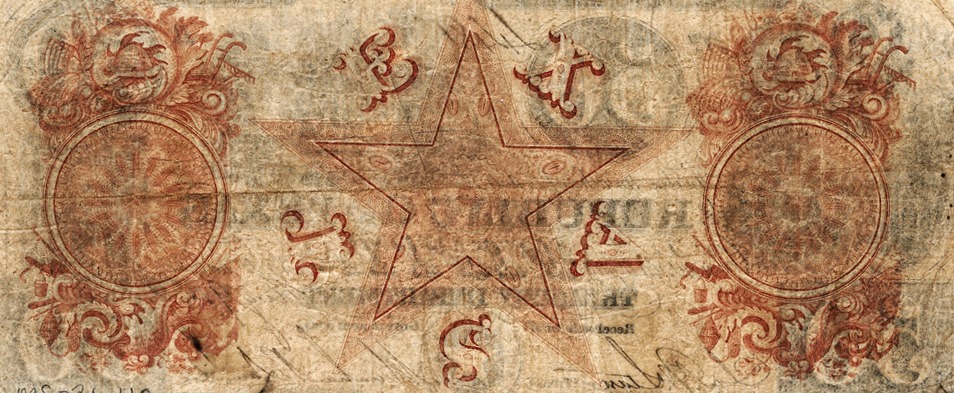By Tara Carron, Archivist and Special Collections Librarian.
While processing the John P. McGovern Collection of Texas Historical Medical Documents, I came across an interesting piece of Republic-era financial history: a beautifully preserved Texas “Redback” banknote. The significance of this curious document nestled within an archival collection primarily comprised of historical medical documents created by Texas doctors during the 19th century is a story worth telling.
A New Republic, a New Currency
Born out of the crucible of the Republic of Texas, the Texas Redbacks are a rare series of banknotes that played a vital role in the fledgling nation’s economic landscape. With its vibrant red ink and impressive design and engravings, the Redback is an intriguing chapter in the story of Texas’ fight for independence.
In the wake of the Texas Revolution and the declaration of independence from Mexico in 1846, the Republic of Texas faced a daunting task: establishing a stable monetary system. To address this pressing need, a new form of paper currency was introduced under Mirabeau B. Lamar’s administration on January 19, 1839. These promissory notes, popularly known as “red backs”, due to their distinctive red ink, came in various denominations. These banknotes became the official medium of exchange for trade, commerce, and government transactions.
Characteristics and Design
The Texas Redback, as the name suggests, featured striking red ink on the reverse side, setting it apart from other contemporary currencies. These intricately designed banknotes boasted engravings that showcased the spirit of Texas, with images ranging from the Texas flag and the iconic “Lone Star” symbol to portraits of influential figures like Sam Houston and Stephen F. Austin.


Legacy and Demise
Throughout its existence, the Republic of Texas grappled with persistent financial challenges. Despite its abundance of land and natural resources, the nation relied heavily on imported manufactured goods, resulting in a rapid depletion of its gold and silver reserves. Compounded by reverberations of the United States’ 1837 bank panic, the Republic faced prolonged economic consequences until around 1845. Annexation to the United States brought much-needed economic assistance, providing a lifeline to a nation in dire need of support.
With Texas’ annexation into the United States in 1845, the era of the Texas Redback Currency came to an end. The Republic’s financial burdens and the instability of the Redbacks necessitated a shift to the more stable U.S. currency.
Today, the Texas Redback has become a cherished collectible among numismatists and history enthusiasts alike. These banknotes serve as a tangible reminder of Texas’ struggle for independence and its early attempts at economic sovereignty. With their distinctive red ink and historical significance, Redbacks continue to captivate collectors and historians worldwide.
References:
E.T. Miller, “Money of the Republic of Texas”. Texas State Historical Collection. Accessed on October 5, 2023. https://www.tshaonline.org/handbook/entries/money-of-the-republic-of-texas
Texas State Library and Archives Commission, “The Republic of Texas Currency”. Accessed on October 5, 2023. https://www.tsl.texas.gov/treasures/republic/currency-01.html